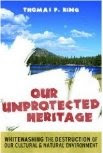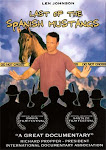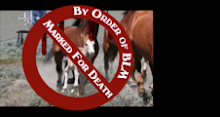 The United States Forest Service (USFS) issued a public scoping notice requesting input for the future management of wild horses occupying the Apache-Sitegreaves National Forest in the Herber Wild Horse Territory (Click Here for Notice). A scoping notice is the very first step government agencies are required to adhere too regarding actions taken with public resources.
The United States Forest Service (USFS) issued a public scoping notice requesting input for the future management of wild horses occupying the Apache-Sitegreaves National Forest in the Herber Wild Horse Territory (Click Here for Notice). A scoping notice is the very first step government agencies are required to adhere too regarding actions taken with public resources.Due to a successful lawsuit filed by Attorney Anthony Merril, JD, of the law firm Bryan Cave, LLP the Animal Welfare Institute, In Defense of Animals, The International Society for the Preservation of Mustangs and Burros and The Conquistador Equine and Rescue Advocacy Program, almost 400 wild horses were saved from slaughter as USFS officials attempted to disregard their duties under the Wild Free-Roaming Horse and Burro Act by citing the animals were just stray livestock and therefore, they could be impounded and sold at livestock auctions. USFS also asserted they were exempt from federal law requiring them to prepare an Environmental Impact Statement demanding proper procedures for wild horse management in the territory.
The Conquistador Equine Rescue and Advocacy Program and Dr. Patricia Haight, Ph.D., has sent out an urgent notice requesting public input on USFS’s proposal by October 2, 2008 and has provided her comments to help inform those interested in the preservation and welfare of the Herber wild horses with some of the issues that need to be addressed. (Click Here)
In addition to Dr. Haights insights, I couldn’t help but add a few of my own you may want to mention, as it is glaringly apparent from the Scoping Notice that USFS is still kicking and screaming about being legally forced to comply with U.S. federal laws requiring their stewardship of OUR resources or having to involve the public at all.
The first clue that extreme prejudice is being exercised is the fact that USFS has already picked a number out of a hat for wild horse populations to be “managed” at. A scoping notice is suppose to identify base issues, not tell the public how it is going to be – that comes later! Furthermore, this is a notice regarding an Environmental Impact Statement (EIS), a document that far exceeds the basic requirements of an Environmental Assessment (EA).
What’s the difference?
Well, an EIS is suppose to be very detailed and requires a large amount of site-specific data on the proposal and area where an EA can get away with reporting more general overviews. Also, an EA is usually written AFTER an EIS has been done with the idea that the EIS provided a complete and comprehensive overview of all the factors that were required to be considered first, before moving on to the EAs. So the short version is, the EIS is suppose to be the grand daddy of analysis on a area.
Yet here USFS has already spelled everything out about “how” the Herber wild horses will be managed while simultaneously providing next to NOTHING in terms of data to support their proposal. In other words, they are already operating completely backwards to how the process is legally required to work, so don’t be surprised when they issue their final proposal next year that looks exactly like this first proposal, as they have clearly already made up their mind about what to do with OUR wild horses and have expressed no interest in acquiring actual scientific data to back up their plans!
So here’s my suggestions for USFS to incorporate that cover primarily two major issues now completely absent from their proposal.
The first is, they are required to offer and examine a range of alternatives in how they will manage the area, a legal requirement they obviously consider abhorrent! What this means is, they are required to pose different formulas for management such as;
In Alternative A, we propose and examine the impacts of managing exclusively for wild horses, remove all livestock grazing and consider big game species subordinate to wild horse needs, or
In Alternative B, we propose to manage mostly for livestock grazing with little wild horse or other wildlife species use, or
In Alternative C, we propose to make big game species as the priority with wild horses and livestock grazing coming in second.
It’s basic but you get the idea. It is suppose to be a range of management alternatives they offer and analyze, not the current – we have decided this is all we are willing to “manage for” and no other public lands use will be considered, analyzed, altered or adjusted.
The second consideration and this is a big one is, there is absolutely no data to support their current numbers and my guess is, they have no intention of working to accumulate or provide the necessary data they need to make an objective analysis.
For example, an EIS is suppose to list every water source in the area, how many gallons per hour it produces (so they can determine how much water is available to support wild horse populations, wildlife and livestock) and if the quality of the water meets federal standards.
They are also suppose to provide data on “forage production”, (i.e., how many pounds of food are totally available in the proposal area so they can then determine what they have to work with when they cut up the forage pie) and “carrying capacity”, which determines how many acres it takes to feed a horse, cow, sheep, deer, etc. for a month. This is how they are suppose to use science to determine proper allocations without causing over stocking (too many animals for the environment to support in healthy ways).
An example might include:
USFS determines 100k pounds of total forage is available within the boundaries of the Herber Wild Horse Territory but of course, they don’t want to allocate it ALL or it would be stripped to the bone and nobody could survive later! So they use a “standard” allocation of 35-50% (35% is the result of the newest studies on rangeland health while 50% is the old standard and is almost ALWAYS used for livestock grazing allocations.)
So, now that they know they have 100k pounds available, they only want to allocate 35k to 50k lbs for use so the area doesn’t end up looking like a desert due to their “management strategies”.
Then they break it down further by determining an Animal Unit Month (AUM) meaning, based on the data above, they figure out how many acres it takes to feed a 1,000 pound animal for a month and this figure will vary depending on the area- deserts obviously produce much less forage than green pastures do! For example, in one area, it may take up to 25 acres at 50% use to feed a horse or cow and calf or it may take as little as 5 acres and that’s how they figure out how much to allocate in their proposals.
Once they get this number, now comes the fun part – who get’s what?
Do they give the bulk of it to livestock grazing? Do they issue wild horse population numbers that are so low they don’t even have to bother allocating them anything? Do they reserve it mostly for “wildlife”? (reading between the lines, this almost always means big game species)
One of the big tricks our government agencies have “converted too” over the years is something called utilization levels. While this technique is good for measuring what is being used on an annual basis, it is NOT a substitute for first determining what is available before they start measuring how much of that available forage can be doled out.
They also like this technique because they are able to decide “what” areas qualify as the “key monitoring areas” they will take the measurements from and these can vary – wild horses may get the crap locations that nothing has grown in for a decade as their “key monitoring area” while livestock get the most prime locations measured before they turn them out to pasture…..
All these factors USFS is hoping the general public is largely ignorant of but consider surprising them by asking them to provide data and information in the EIS that covers:
*Forage production (before and after the wildfire damage)?
*Carrying capacity (before and after the wildfire damage)?
*Acres allocated per Animal Unit Month?
*Current and historical grazing allocations for livestock?
*Temporary grazing permits issued in the last 10 years?
*Total available water sources in the area?
*Gallons per hour of these water sources?
*How many water sources have been fenced?
*Miles of fencing in the area?
*Total big game species populations in the area, including how many they ultimately plan to manage for if those species are not currently at their maximum population targets?
*How they plan to distinguish wild horse use from other rangeland users?
For extra credit, ask USFS why they are putting the cart before the horse in deciding how to “keep the populations low” through the use of fertility control when they have failed to report on how many wild horses can actually be supported in the area first or what their reproduction rates actually are?
All public comments must be submitted by
October 2, 2008 4:30 p.m.
~Contact~
Allison L. Stewart/Acting Forest Supervisor
Apache-Sitgreaves National Forest -Supervisor’s Office
30 South Chiricahua Drive, P.O. Box 640,
Springerville, AZ 85938-0640
Phone: 928-333-4301 Fax: 928-333-5966
Email: r3_asnf_herber_horse@fs.fed.us
All public comments and personally identifying information will become part of the public record will be available for public review. Comments must include your name, address, telephone number, and organization represented, if any, as well as the title Herber Wild Horse Territory Management as well as specific facts along with supporting reasons that you believe should be considered.
Photo of Herber Wild Horse taken from Wild Heart Ranch http://www.wildheartranch.com/kidsclub/EAN/kc_Horses_in_Arizona_forest_wild_or_domestic_strays.asp































